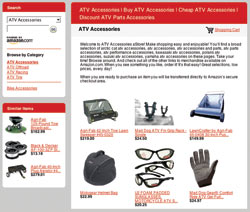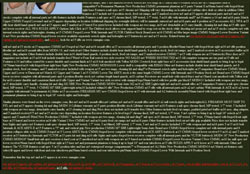When writing Website copy, thinking like a search engine is usually a good thing. Go too far with it, though, and you can end up with spam-flavored Web content that will negatively impact your site’s usability at best — and get your site banned from search engines at worst. So in thinking like a search engine, it’s also useful to tune your brain to anticipate the decisions of a spam filter.
Search engine theory
Before you can learn to write great Web copy, you must understand how a search engine works. Search engines look at the HTML code that makes up your Web page and attempt to extract the text content. This page copy goes into the search engine’s index — a large database of Website information — along with a record of the page’s incoming and outgoing links.
When you use a search engine, it traverses its index and forms a list of all of the Web pages that include your search term — in the page title (i.e., title tag), page copy, and/or link text (i.e., the clickable text that forms the link). The results are then weighted based in large part on the number, importance and trustworthiness of the links pointing to each page.
So if you have a Web store, and your pages do not include the words most users search for when they’re looking for whatever you’re selling, it is unlikely that your pages will rank well in search engines, if they’re even indexed. The same holds true when none of the link text in the links leading to those pages include the words for which the user searched.
Once pages have been identified, search engines order the results according to relevance. Relevance can be determined based on dozens — if not hundreds — of criteria. (Google engineers refer to these criteria as “signals.”) Two such criteria are keyword density (the number of occurrences of your keywords) and keyword prominence (where in the HTML your keywords appear). Knowing this bit of information may initially encourage you to start carpet-bombing your site with relevant keywords, and that’s when you start getting into spam territory.

Take this Amazon aStore for ATV accessories, for instance. That header is one big, spam-scented, keyword-stuffed link to a second Amazon aStore page, presumably owned by the same person. The introductory paragraph is a bit spammy as well, and doesn’t contain any useful information. If you were a really intelligent search engine (and the major search engines — Google, Yahoo and Live Search — definitely all qualify), what would you think of a link at the top of a page with all of those keywords in it? If you would think, “Hmm … tastes like spam,” then you’re on the right track.
Crafting your page
As you begin thinking like a search engine, you might examine your existing Web copy and realize that it is far too verbose in the first few paragraphs. It might also occur to you that the title tag for the page you are working on doesn’t have the most important keywords listed first — in fact, they might be last!
Moving the most important keywords for that page to the beginning of the title tag, as well as moving those keywords to the top of the page copy, can really help to boost your rankings. This again is the concept of keyword prominence, and it works at the micro level (i.e., within a tag like a title tag) as well as the macro level (i.e., within the page in its entirety).
But don’t go overboard with keyword density, the number of times your keywords appear on a page. Too many occurrences of your keywords on a page will trip the spam penalty algorithm, which will damage your page’s relevance score. Also, if you are going after a particular keyword phrase, your Web page will appear more relevant if the individual words in that phrase appear together as that exact phrase in your page copy.
In addition to placing your selected keywords at the beginning of your title tag and also in the first paragraph or two of page copy, it also helps to emphasize your keywords by enclosing them in heading tags (i.e., “H1”). Carefully consider the optimal page structure; design your content so that your keywords appear inside heading tags, body copy and other tags; then write something interesting and compelling.
Once you have thought about each of these points, it’s time to start writing. Ideally, write at least a couple hundred words of copy for each of your pages. This is by no means a rule, but it is a useful guideline to follow. But even 50 words of keyword-focused copy is better than nothing — i.e., images and a copyright statement.
When you are creating links, be sure to include good keyword-rich text in your link text. Avoid using phrases such as “click here” and “more info” in your links (they say nothing to search engines), and instead choose words that are relevant to the page the link will go to.
Don’t get carried away with keywords in your page copy. There is such a thing as going too far; when your copy becomes incomprehensible to human beings, it is in the danger zone for search engine spam filters.

If the previous example wasn’t enough to convince you, here’s a more exaggerated case of a page on an online rifle store that is, well, total overkill. This is nothing but pure gibberish! What you see on the screen here is an example of overzealous keyword density. At this level, keyword density ceases being an asset and instead becomes a spam tactic called keyword stuffing.
This is also a primitive kind of doorway page, which is a Web page stuffed with keywords that is designed to fool search engines into giving it more prominence while showing (or appearing to show) useful information to human visitors. If you were to scroll up in the picture to the right, you would see what most humans see when they visit this page, which is a “click here to enter” graphic and some sales contact information for this company, followed by a bunch of blank spaces to force the spam text off the bottom of the screen.
Scroll down and you get the wall of nonsense shown. Search engines are smart, though, and so this obvious spam page is completely absent from Google’s index.
Testing the waters
Once you put these tips and tricks into practice on your own site, don’t just assume that you have gotten it right, especially if you are new at this. Run your copy past a human being or two to ensure that it is interesting and engaging, and communicates your message effectively.
Once you have human approval, run the draft page through a search engine spider simulator, such as the one at www.feedthebot.com/tools/spider/. These tools will tell you how many times you used each keyword.
The final test is linking your new page to the rest of your site and seeing how it performs in the search results. If the results are lower than expected, make some adjustments by moving text around, adding or subtracting copy, and so forth. Pay attention to your title tag, as this bit of text is given the most weight by the search engines.
To convince visitors to click through to your site from the search results, write a descriptive summary of your page and include that as a meta description (a meta tag). Make sure it contains the targeted keywords that you have chosen for this page, and be brief. While this does not help with your search engine ranking, it can improve the quality of your page description in the search results.
Stephan Spencer is founder/president of natural search marketing firm Netconcepts and co-author of The Art of SEO, due out in 2009.